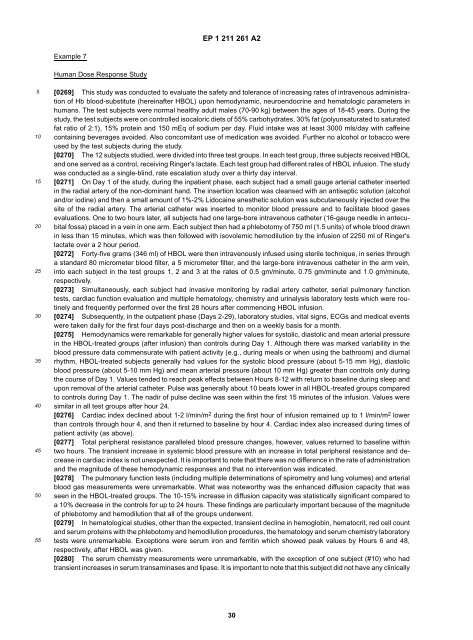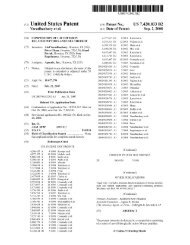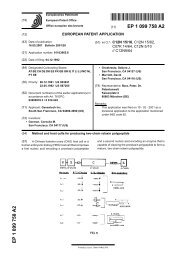EP 1 211 261 A2
EP 1 211 261 A2
EP 1 211 261 A2
You also want an ePaper? Increase the reach of your titles
YUMPU automatically turns print PDFs into web optimized ePapers that Google loves.
<strong>EP</strong> 1 <strong>211</strong> <strong>261</strong> <strong>A2</strong>Example 7Human Dose Response Study510152025303540455055[0269] This study was conducted to evaluate the safety and tolerance of increasing rates of intravenous administrationof Hb blood-substitute (hereinafter HBOL) upon hemodynamic, neuroendocrine and hematologic parameters inhumans. The test subjects were normal healthy adult males (70-90 kg) between the ages of 18-45 years. During thestudy, the test subjects were on controlled isocaloric diets of 55% carbohydrates, 30% fat (polyunsaturated to saturatedfat ratio of 2:1), 15% protein and 150 mEq of sodium per day. Fluid intake was at least 3000 mls/day with caffeinecontaining beverages avoided. Also concomitant use of medication was avoided. Further no alcohol or tobacco wereused by the test subjects during the study.[0270] The 12 subjects studied, were divided into three test groups. In each test group, three subjects received HBOLand one served as a control, receiving Ringer's lactate. Each test group had different rates of HBOL infusion. The studywas conducted as a single-blind, rate escalation study over a thirty day interval.[0271] On Day 1 of the study, during the inpatient phase, each subject had a small gauge arterial catheter insertedin the radial artery of the non-dominant hand. The insertion location was cleansed with an antiseptic solution (alcoholand/or iodine) and then a small amount of 1%-2% Lidocaine anesthetic solution was subcutaneously injected over thesite of the radial artery. The arterial catheter was inserted to monitor blood pressure and to facilitate blood gasesevaluations. One to two hours later, all subjects had one large-bore intravenous catheter (16-gauge needle in antecubitalfossa) placed in a vein in one arm. Each subject then had a phlebotomy of 750 ml (1.5 units) of whole blood drawnin less than 15 minutes, which was then followed with isovolemic hemodilution by the infusion of 2250 ml of Ringer'slactate over a 2 hour period.[0272] Forty-five grams (346 ml) of HBOL were then intravenously infused using sterile technique, in series througha standard 80 micrometer blood filter, a 5 micrometer filter, and the large-bore intravenous catheter in the arm vein,into each subject in the test groups 1, 2 and 3 at the rates of 0.5 gm/minute, 0.75 gm/minute and 1.0 gm/minute,respectively.[0273] Simultaneously, each subject had invasive monitoring by radial artery catheter, serial pulmonary functiontests, cardiac function evaluation and multiple hematology, chemistry and urinalysis laboratory tests which were routinelyand frequently performed over the first 28 hours after commencing HBOL infusion.[0274] Subsequently, in the outpatient phase (Days 2-29), laboratory studies, vital signs, ECGs and medical eventswere taken daily for the first four days post-discharge and then on a weekly basis for a month.[0275] Hemodynamics were remarkable for generally higher values for systolic, diastolic and mean arterial pressurein the HBOL-treated groups (after infusion) than controls during Day 1. Although there was marked variability in theblood pressure data commensurate with patient activity (e.g., during meals or when using the bathroom) and diurnalrhythm, HBOL-treated subjects generally had values for the systolic blood pressure (about 5-15 mm Hg), diastolicblood pressure (about 5-10 mm Hg) and mean arterial pressure (about 10 mm Hg) greater than controls only duringthe course of Day 1. Values tended to reach peak effects between Hours 8-12 with return to baseline during sleep andupon removal of the arterial catheter. Pulse was generally about 10 beats lower in all HBOL-treated groups comparedto controls during Day 1. The nadir of pulse decline was seen within the first 15 minutes of the infusion. Values weresimilar in all test groups after hour 24.[0276] Cardiac index declined about 1-2 l/min/m 2 during the first hour of infusion remained up to 1 l/min/m 2 lowerthan controls through hour 4, and then it returned to baseline by hour 4. Cardiac index also increased during times ofpatient activity (as above).[0277] Total peripheral resistance paralleled blood pressure changes, however, values returned to baseline withintwo hours. The transient increase in systemic blood pressure with an increase in total peripheral resistance and decreasein cardiac index is not unexpected. It is important to note that there was no difference in the rate of administrationand the magnitude of these hemodynamic responses and that no intervention was indicated.[0278] The pulmonary function tests (including multiple determinations of spirometry and lung volumes) and arterialblood gas measurements were unremarkable. What was noteworthy was the enhanced diffusion capacity that wasseen in the HBOL-treated groups. The 10-15% increase in diffusion capacity was statistically significant compared toa 10% decrease in the controls for up to 24 hours. These findings are particularly important because of the magnitudeof phlebotomy and hemodilution that all of the groups underwent.[0279] In hematological studies, other than the expected, transient decline in hemoglobin, hematocrit, red cell countand serum proteins with the phlebotomy and hemodilution procedures, the hematology and serum chemistry laboratorytests were unremarkable. Exceptions were serum iron and ferritin which showed peak values by Hours 6 and 48,respectively, after HBOL was given.[0280] The serum chemistry measurements were unremarkable, with the exception of one subject (#10) who hadtransient increases in serum transaminases and lipase. It is important to note that this subject did not have any clinically30




